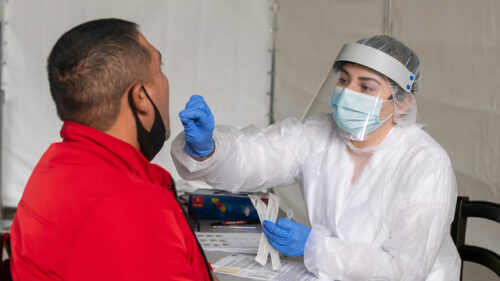For over half a year, the global pandemic caused by COVID-19 has left over a million people dead and tens of millions of people sick. And it’s not slowing down. Without an official vaccine approved in the US, most healthcare providers across the nation have relied on reverse transcriptase polymerase chain reaction (RT-PCR) tests to detect severe acute respiratory syndrome coronavirus 2 (SARS-CoV-2) in high-risk populations such as nursing home residents, hospitalized patients, and health care workers. RT-PCR tests, administered using nasal or throat swabs, work by identifying viral RNA from patient samples. But can we actually trust them?
In a study published in the Annals of Internal Medicine, researchers at Johns Hopkins University addressed this very question. Led by Lauren Kucirka, an obstetrics and gynecology resident at Johns Hopkins Medicine, the team studied the sensitivity of respiratory PCR-based tests and the probability of false negatives during a crucial “window period” after infection. Sensitivity is a measure of a test’s ability to correctly identify positive results for people who have the condition. A false negative occurs when a patient who is actually positive for the condition receives a negative test result, usually due to very low amounts of virus in the sample that go undetected.
Accurate test results for COVID are extremely important because hospitals, workplaces, universities, and other institutions use them to make decisions and implement policies. “With limited resources, hospitals use these tests to rule out infection and conserve personal protective equipment,” Kucirka said. “When exposed healthcare workers or patients test negative, they can be cleared to return to work, and certain measures to prevent the spread of infection can be removed. This poses a major threat if these tests are not as reliable as we think they are.”
Kucirka and her team applied a statistical model to analyze data from seven published studies. Their set represented a total of 1330 RT-PCR-tested respiratory samples, collected from patients who either exhibited symptoms or had known exposure to the virus, with information on the test’s performance over time.
The team found that one day after initial exposure, the false negative rate was one-hundred percent. In other words, if you take the test one day after close contact to COVID, it is essentially useless. After four days, that rate only decreased to sixty-seven percent. On the fifth day, the average point of symptom onset, false negatives still occurred in thirty-eight percent of patients. Never did this rate drop below twenty percent, revealing the frighteningly low sensitivity of PCR-based tests for SARS-CoV-2. Put simply, based on the researchers’ results, at least one in five people who have COVID will receive a negative result from a respiratory PCR test.
Such results will not necessarily be fixed by improved testing methods, as there are biological limitations inherent to any viral testing. We can see similar rates of false negatives with tests for other viruses, such as the flu. Rather, Kucirka believes these results should be used to educate and inform policies and protocol, especially regarding high-risk populations. “I think the most important thing is to understand that the test is a tool,” Kucirka said. “It’s the best tool we have, but we have to understand that it’s not perfect and that false negatives are possible. If a patient had a high-risk exposure or is exhibiting convincing symptoms, the conservative thing to do is to treat that person as infected.”
Kucirka also stressed that the data were from studies extremely varied in design and conduct, which may have significantly affected their results, although the team’s sensitivity analysis showed consistent results despite this heterogeneity. In the future, she hopes that more uniform data can be collected to provide more accurate estimations of the false negative rate.
“That’s why we made our data and statistical code publicly available,” said Kucirka. “Hopefully as more data comes in, other researchers will use the code, and the results will be updated with more accurate numbers.”
Currently, Yale tests its on-campus undergraduate students using these respiratory PCR-based tests, administered two times a week. However, the low sensitivity of the test may pose a major threat to the university and others like it. In response, Kucirka emphasized the importance of preventative measures like social distancing and wearing masks. Given the results of her study, it is clear that we must remain conservative and cautious in our activities to ensure our safety as a community, rather than rely on testing alone to completely eliminate risk.
Kucirka, L. M., Lauer, S. A., Laeyendecker, O., & Boon, D. (2020). Variation in False-Negative Rate of Reverse Transcriptase Polymerase Chain Reaction–Based SARS-CoV-2 Tests by Time Since Exposure. Annals of Internal Medicine, 173(4), 262-267. doi:10.7326/M20-1495

